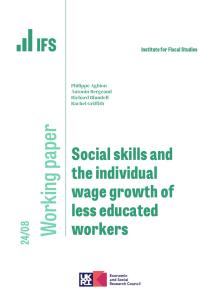Since the early 2000s, public spending on adult education has dropped by nearly one-third. Alongside that, employer spending on training has decreased by 27 per cent per trainee since 2011.
This decline in training investment has occurred alongside a fall in participation. The number of publicly funded qualifications started each year by adults has dropped from nearly 5.5 million in the early 2000s to 1.5 million by 2020. And the average number of days of workplace training received each year is almost 20 per cent lower than in 2011.
These are eye-opening statistics. On the face of it they seem a cause for concern, but they require context. Some of the reduced government funding supported adult courses with modest returns. Additionally, subsidies for private training often went to training that would have happened anyway – a phenomenon economists call ‘dead weight’.
However, given the scale of the decline in training participation and ongoing concerns about skills shortages and low productivity it is worth considering how the existing skills system could be reformed and improved.
Clearly this is not a straightforward task. In our new report, Investment in training and skills, part of the IFS Green Budget 2023, we set out options for reforming the funding and financing of adult education in England. One of the key policy areas we consider is the apprenticeship levy, which has been the subject of much scrutiny lately.
Introduced in 2017, the apprenticeship levy is a tax on large employers (with a pay bill over £3 million). In England, the revenue generated through the levy is used to provide subsidies for apprenticeship training costs. Levy-paying employers can access a subsidy for 110 per cent of training costs (i.e. the full costs and a 10 per cent top-up), while non-levy-paying firms can subsidise 95 per cent of apprenticeship training costs.
There are sound economic grounds to provide financial support for training. Employers often face borrowing constraints and might not account for the broader benefits of their investment, which leads to under-investment. Yet there are three features of the existing subsidy system that raise questions.
First, the subsidy rates introduced in 2017 mark a significant increase on historic rates, which typically funded half the apprenticeship costs for adults. The rates are also higher than those currently set in Scotland (up to 50 per cent) and Northern Ireland (50 per cent) for older apprentices. The risk of such a high subsidy rate is that it might steer employers towards apprenticeships without thorough consideration of whether they satisfy their actual training needs, and may also lead to significant ‘dead weight’ costs.
Second, there is a differential subsidy rate for levy and non-levying paying firms. While it may be tempting to argue that levy-paying firms deserve a higher subsidy rate because they have borne the costs of the tax, this is misguided. If subsidy rates were to vary, they should be directed at firms facing the biggest constraints to investment, which may well be smaller (non-levy paying) firms.
In practice, it is difficult to measure the level of barriers to investment in training faced by different employers. Instead, a uniform subsidy rate for all employers set at a lower rate than the existing rates is likely to be both more appropriate and much simpler to administer.
Third, subsidies are solely focused on apprenticeships, but other forms of training may also be under-provided. In this context, the Labour Party has proposed to transform the apprenticeship levy into a broader growth and skills levy which will extend financial support to other forms of training.
There is appeal in balancing incentives across different forms of training. Yet past experience with programmes such as individual learning accounts and train to gain shows that there is a need for effective regulation to ensure that this policy does not simply subsidise existing employer-provided training. In other countries with broader training subsidies, policymakers have drawn up lists of approved qualifications that are eligible for subsidies.
The current skills landscape suggests a need for action. Clear and stable incentives for high-quality training are essential irrespective of how training is labelled. There are concrete steps, such as reforming the apprenticeship levy, that the government should take to improve the existing skills system.
This article was first published in FE Week and is reproduced here with kind permission.









